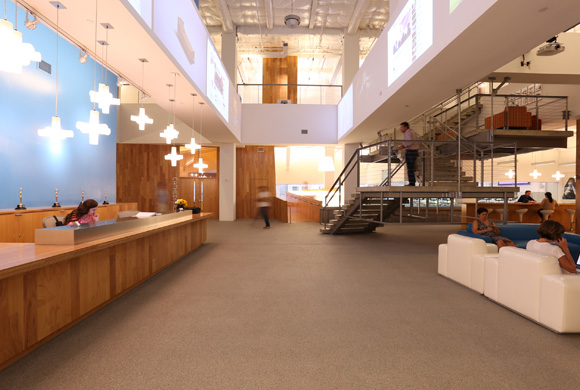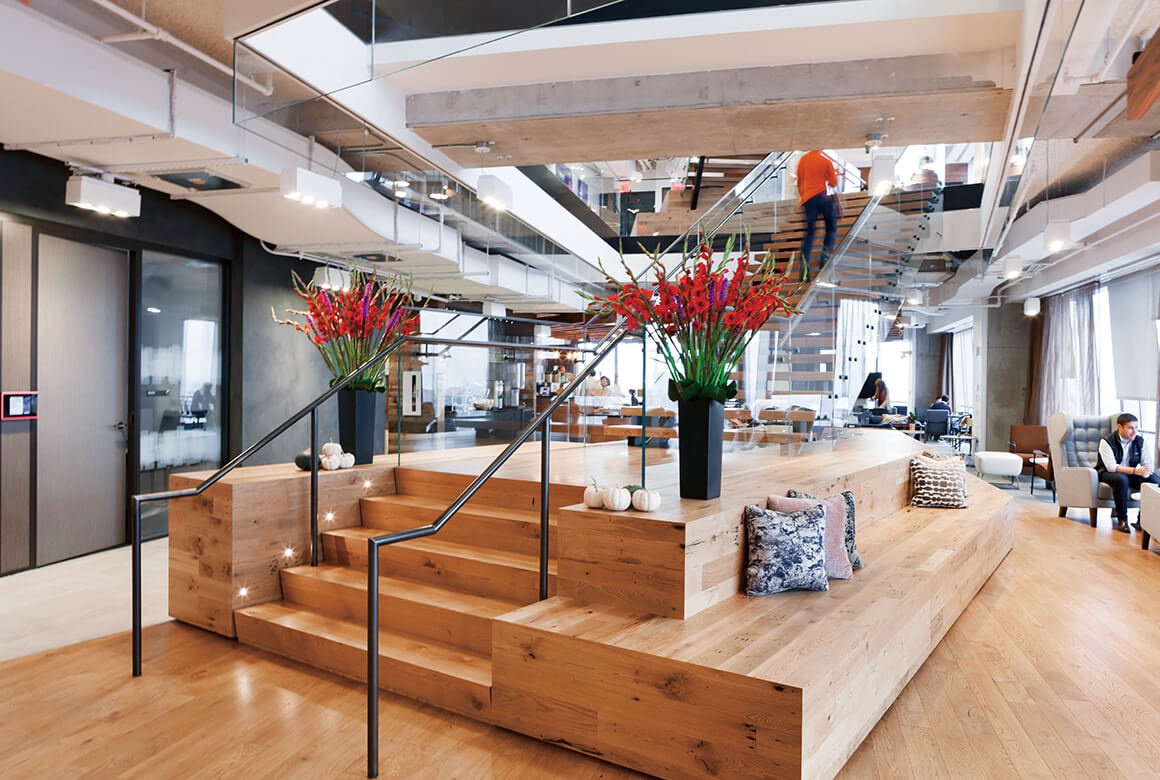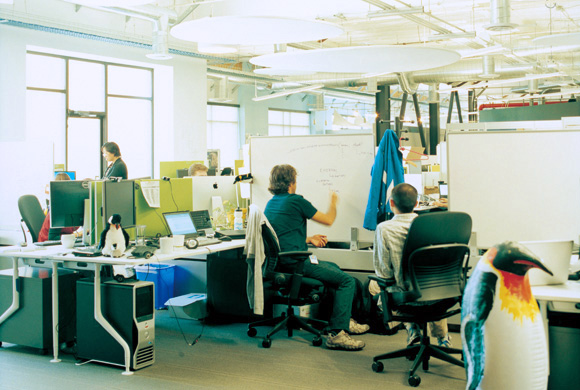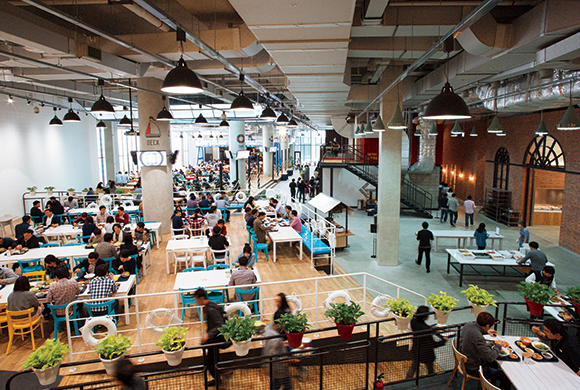Workplace
Jul. 1, 2019
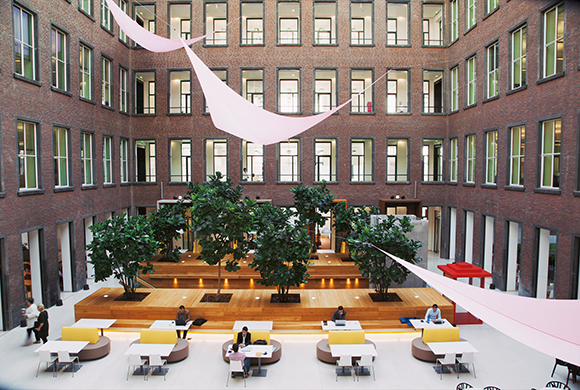
Beating the competition by respecting the individual
Netherlands’ leading energy company
[Essent (An RWE company)] s-Hertogenbosch, Netherlands
Europe has a lot of energy suppliers. In an environment where the only way to stand out from the crowd is through price, these companies are trying to find new ways to survive, which don’t always involve the supply of electricity. In Essent’s case, “we didn’t have the resources to accomplish everything we wanted to,” reminisces Marcel Broumels, Innovation Acceleration Manager, formerly involved with Facility Services. “So we all had to get creative and increase productivity.”
Sure enough, the radical reforms carried out by Essent in 2009-2012 increased employee freedom over where and when they worked, and steered the company towards greater respect for the individual. The transformation saw fixed desks abolished and employees working two days a week from home.
All at once, the company’s 13 offices around the country were reduced to 4. Essent had succeeded both in cutting operating costs and increasing productivity.
We visited Essent’s headquarters in the quiet rural town of s’Hertogenbosch. While the old building remains, it has been extended and dramatically redesigned. The space has been designed in accordance with the concept of activity based working, so instead of individual fixed desks, employees are provided with a variety of workspaces. Staff choose an appropriate spot from among the range on offer, including open areas, sofas and standing desks, according to what they are working on at the time. For times when work demands concentration and privacy, they can shut themselves away in private concentration booths.
The vast atrium on the ground floor is also counted as a workspace, although it was originally intended as a multipurpose open space. On our visit we saw people deep in conversation, coffee in hand, people eating lunch, and others having meetings: truly a multipurpose space. In the mornings and evenings it’s apparently popular as a lounge.
Down the stairs from the atrium are the basement meeting rooms. Once cold, concrete spaces unpopular with staff, now their friendly design draws on football and the deer sanctuary which Essent supports.

Exterior. The tower-like projection to the left of the photograph is the atrium.
Established: 1999
Turnover: approx. 4.4 billion Euros (2014)
Employees: approx. 2700 (2014)
https://www.essent.nl/

Corridors linking the atrium building to different floors of the extension. The walls of the old building have been retained in the hope that the external viewpoint will have a galvanizing effect.
Put simply, this is a “work anywhere” office, and the employees certainly seem to be making the most of their freedom. But that hasn’t always been the case. Even now, staff tend to form occupation-based clusters. It’s only natural for people to gravitate towards the areas and desks that they are used to. When fixed desks were first abolished, people said things like, “We won’t know how to find people,” and “We need a tool or an app.” The company’s response was an unequivocal “No.”
“We made a conscious decision not to provide too much tools to facilitate building users. ‘It’s just like arranging to meet a friend at the pub,’ we said. You’re in the same building, so just walk around and look for them, or give them a call. We want people to be creative, to use their heads and think for themselves, instead of relying on technology too heavily.”
Along with the transformation of the office itself, another change that has had just as big an impact on how people work has been the promotion of working from home. Currently, the average is three days a week in the office and two days working from home. The biggest benefit of remote working has been increased productivity. In addition, encouraging people to work from home has cut the need for physical office space, resulting in a huge reduction in operating costs.
In 2009, before implementing its change management plan, Essent carried out a survey into working from home. People from 22 different job categories worked from home for a year, and at the end of that time productivity had increased by 15%. Absence due to illness had also fallen by 20%, perhaps because if people are at home they feel able to do some work even if they are unwell. The overall reaction was decidedly positive, claiming improved work life balance.
“The biggest advantage of working from home is that you can use your time however you want. For example, in the past you might have had to take a half day off just to take the car to the garage, but now it’s much easier. I’ve experienced the increase in productivity for myself. I can get as much done in a day or two at home as I can in a week at the office. It’s very efficient.”
Working from home has also had a hand in increasing the number of outstanding job candidates that have started coming Essent’s way. Some of the factors in choosing an employer in the Netherlands are supposedly freedom, managers, and salary. Essent stands out in terms of employee freedom, which may explain why more people now want to work here.
But has the increase in individual freedom and productivity translated directly into increased productivity for the organization? If more people are working from home, with less face time with colleagues, surely they get lonely? Is there no detrimental effect on team spirit?
“It’s true that work doesn’t progress if teams don’t talk to each other. So they do still need to come into the office. When we started the working from home system we decided that two days a week there would be team meetings, two days a week would be for working from home, and on the remaining one day everyone would come into work again. But we didn’t just want people to come in to talk about work. We arranged for them to go to the pub next door to talk about things other than work, and found that people naturally started talking to each other more, fostering greater team spirit.”
Thinking about it, there is evidence even within the office of efforts to build and maintain team spirit. Abundant use of the corporate colour (pink) is meant to remind people that they are part of Essent. Free coffee makers dotted around encourage people to stop for a chat. Surprisingly, though, employees prefer to pay for their drinks at the café. “I don’t think it’s because the coffee’s better,” says Broumels. He thinks people intentionally gather at the café to enjoy the act of buying a freshly made coffee whilst talking to their colleagues. It’s an experience you just don’t get if you’re working from home.
Whilst employees are united in praising the freedom to work whenever and wherever they want, they still value the office and their colleagues. Some even prefer working in the office and come in four days a week.
“If people want to come in more often I’m not going to stop them. On the other hand, I don’t mind if they come in just one day a week. It’s important that they have that choice. Always assuming that they are contributing to good team performance, of course. But how they work is up to the individual. How they can work happily within their team, that’s what everyone has to think about. Everyone chooses their own way of working.”

A private concentration booth at the back of the first floor office space.

The 1st floor office space. Some departments, like this one, still have fixed desks, depending on what they do.

Essent received the Dutch Winning Workplace Award for 2013-2014

Marcel Broumels
Innovation Acceleration
Manager
Essent’s change management didn’t stop with adapting the office space. It was much more drastic than that, involving reforms to the way people actually worked, like working from home.
A look at how Essent’s workspace has changed over time reveals a consistent pursuit of cost and maintenance savings combined with increased efficiency. What was a traditional office in the 80s became open plan in the 90s. Fast forward to the 2010s, however, and a move towards a completely different working environment is underway.
What is important in the Essent outlook is not where to put things, but how to work. The project title, “How Do We Work Together?” gets right to the point. Office design is no longer the sole responsibility of the Facilities Department. This project was planned by a number of departments working together, including IT, HR, and Facilities.
Manager Broumels, formerly part of the Facility design as well as future world of work cultural change team, was one of those involved in the project. He acknowledges that it goes far beyond the remit of Facilities. “For me, the next step isn’t facilitation of the building, but how to facilitate the organisation. I think we’ll need to start thinking not just about visible things like products and working environments, but about intangible things like creativity and team spirit. That’s why I joined the innovation team as an innovation acceleration manager.”
The project planning stage lasted from 2008 to 2010. After spending 30 weeks explaining the new facilities and rules to all managers in detail, they moved on to briefing teams, setting out exactly what the changes would entail. Then the reforms were carefully implemented, with the help of continual monitoring and feedback.
What is striking in terms of changes to working styles is the changing roles of managers and their staff. Previously, a manager’s role was mainly to give instructions. But that doesn’t fit with “anytime, anywhere working”.
Working on average two days a week from home has created a physical distance between managers and their teams. With more people working from home more often, workers take up less space in the office. As a consequence, where Essent previously had 13 offices around the country, it now has 4. Even here at the headquarters in ‘s-Hertogenbosch, only 30,000 of a total of 60,000 square metres of floor space are actually being used. Moreover, workers don’t belong to a single office, but can choose to work wherever they like. Naturally, this puts even more of a distance between managers and their staff.
“For example, if it’s too much trouble for someone living in Amsterdam to go all the way to Den Bosch for work, they can work from home, or they can use an external office location somewhere else. People use different places for different reasons.”
Now that this way of working has taken root, Broumels explains that what managers are now expected to do is to “provide tools that allow employees to work independently.”
“Our change management is partly based on the idea of every employee becoming an entrepreneur. Which means that one of the manager’s important functions is to support that. Rather than giving staff work to do and overseeing it, managers need to be part of the team, explaining what needs to be achieved and expecting staff to take responsibility. In Essent job interviews people are being asked whether they are able to work from home and whether they can work independently.”
Introducing working from home has been a way of fostering a self-reliant entrepreneur mentality among employees. To support this, the company provides an allowance towards buying desks, chairs and printers for home working. This is also a way of giving some of the profit made as a result of needing less office space back to employees. “If we get good results, we can reward employees. If it makes them happier in their work, they’ll work more efficiently as a result,” smiles Broumels.
Nevertheless, he discloses, some managers are still struggling to break away from traditional methods.
“In future it might be more appropriate to call them leaders, guides, rather than managers. Normally, managers are interested in checking all the details. ‘How’s that work coming on?’ ‘What have you done?’ ‘When will it be finished?’ But a leader needs to pay more attention to the overall picture than the individual details. Things like, ‘How are you holding up?’ ‘Have you got enough time?’ ‘We’ve had some feedback – it might be better to work with so-and-so.’ Looking at the wood rather than the trees, so to speak. Not checking every little detail, but making sure that every part is functioning properly as part of the whole.”
Of course, it’s not just the managers who are perplexed. Some things are difficult for staff to adapt to, as well.
Anyone would surely dance for joy on hearing they could work from home two days a week. The fact that Essent provides laptops, smart phones and ear pieces so that employees can log in from anywhere and take part in meetings over the network makes things even easier. Nevertheless, warns Broumels, “The truth is that working from home has its bad points. Firstly, we noticed that people were tempted to work too hard. When you work from home you start to feel guilty, like you’re skiving. They say that Dutch people are more laid back than Germans and Japanese people, but we’re still apprehensive when it comes to work. Some people check their emails all the time on our phones and we’ve seen occasions where people send emails late at night to ‘prove’ that they’re working. These things occur. I think it’s something managers may have to deal with. When their staff do come into the office, managers will need to be sure to check on work progress and find out if people need any help, as well as giving instructions and relaying information. Finding a balance between work and time off is going to be a big issue for both managers and staff going forward.”
From WORKSIGHT 07(2015.4)

These meeting booths at the back of the ground floor open space are both open and enclosed, making it easy to settle down and concentrate on a conversation.

IT systems are used to book meeting rooms by scanning QR codes. The same system can be used to quickly alert the maintenance team to a broken coffee machine. Smart ideas minimize facility management effort.

Staff are provided with laptops, smart phones, and earpieces with microphones to support the Essent way of working. Skype is a popular means of communication for people working remotely.

What looks like a bar is actually a standing desk, used for standing meetings and working on laptops.










